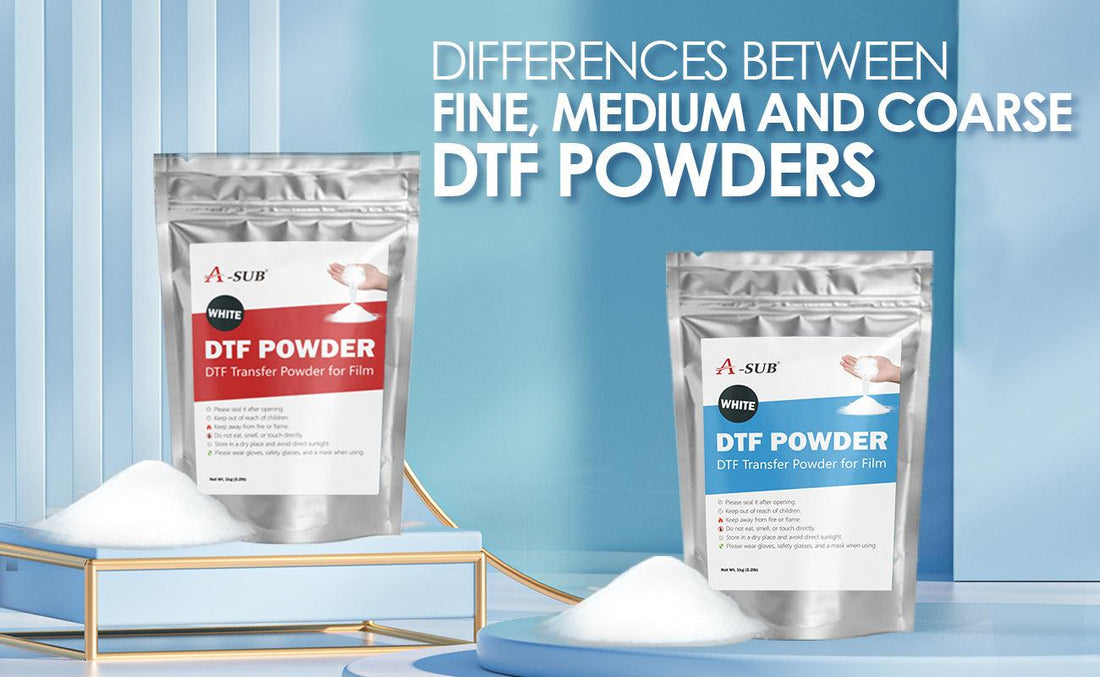After reading about the differences between the different DTF powders, I still am confused as to which one I should use for 100% cotton sweatshirts and hoodies. Could you please direct me as to which one I should purchase for this type of material. Thank you for your excellent products.
Linda Armstrong
Understanding the Differences Between Fine, Medium, and Coarse DTF Powders

Direct-to-film (DTF) printing has revolutionized the world of textile printing, offering versatility and quality that traditional methods often struggle to match. At the heart of DTF printing lies the DTF powder, a crucial component that determines the quality, durability, and overall outcome of the print. DTF powders come in various forms, categorized primarily as fine, medium, and coarse. Each type has its unique characteristics, serving different purposes and offering distinct benefits. In this comprehensive guide, we delve into the differences between fine, medium, and coarse DTF powders, shedding light on their properties, applications, and advantages.
Understanding DTF Powder
Before diving into the specifics of fine, medium, and coarse DTF powders, let's first understand what DTF powder is and its role in the printing process. DTF powder, also known as adhesive powder, is a specialized material used in direct-to-film printing. It acts as a bonding agent between the ink and the fabric, ensuring proper adhesion and durability of the print. DTF powder is applied onto the printed design before heat pressing, creating a strong bond between the ink and the fabric substrate.
Fine DTF Powder
Fine DTF powder is characterized by its small particle size, typically ranging from 50 to 100 microns. The fine texture of this powder allows for smooth application and even distribution across the printed design. Fine DTF powder offers the following advantages:
- Smooth Finish: Fine DTF powder creates a smooth and uniform surface, resulting in high-resolution prints with sharp details and vibrant colors.
- Enhanced Clarity: Due to its small particle size, fine DTF powder ensures excellent ink penetration, leading to enhanced clarity and definition in the print.
- Ideal for Intricate Designs: Fine DTF powder is well-suited for intricate designs and fine lines, as it prevents ink bleeding and smudging during the printing process.
Fine DTF powder is commonly used for high-quality prints where precision and detail are paramount, such as photographic images, logos, and intricate artwork.
Medium DTF Powder
Medium DTF powder falls between fine and coarse powder in terms of particle size, typically ranging from 70 to 170 microns. This powder offers a balance between smooth application and good coverage, making it a popular choice for a wide range of printing applications. Here are some key characteristics of medium DTF powder:
- Versatility: Medium DTF powder is versatile and suitable for various fabric types and printing projects, from garments to promotional items.
- Ease of Application: The medium particle size of this powder ensures easy application and distribution, resulting in consistent and reliable prints.
- Good Coverage: Medium DTF powder provides adequate coverage, ensuring proper adhesion of the ink to the fabric substrate without excessive buildup.
Medium DTF powder is often preferred for general-purpose printing, including T-shirts, sweatshirts, bags, and other textile products.
Coarse DTF Powder
Coarse DTF powder has the largest particle size among the three types, typically ranging from 170 to 300 microns. This powder offers robust adhesion and durability, making it suitable for challenging printing conditions and heavy-duty applications. Here are the distinguishing features of coarse DTF powder:
- Strong Adhesion: Coarse DTF powder provides strong adhesion between the ink and the fabric, ensuring long-lasting prints that withstand washing and abrasion.
- Suitable for Textured Surfaces: Due to its larger particle size, coarse DTF powder effectively bonds with textured or uneven fabric surfaces, ensuring uniform coverage and adhesion.
- Resilience: Coarse DTF powder offers excellent resilience and durability, making it suitable for outdoor applications, sportswear, and other high-wear items.
Coarse DTF powder is commonly used for challenging substrates, such as polyester blends, nylon, and performance fabrics, where strong adhesion and durability are essential.
Conclusion
In conclusion, fine, medium, and coarse DTF powders each offer unique properties and advantages, catering to different printing requirements and substrate types. Fine powder excels in producing high-resolution prints with intricate details, while medium powder provides versatility and reliability for general-purpose printing. Coarse powder, on the other hand, offers robust adhesion and durability, making it ideal for challenging substrates and heavy-duty applications. By understanding the differences between these powders, printers can optimize their printing processes and achieve superior results across a wide range of projects.




comment